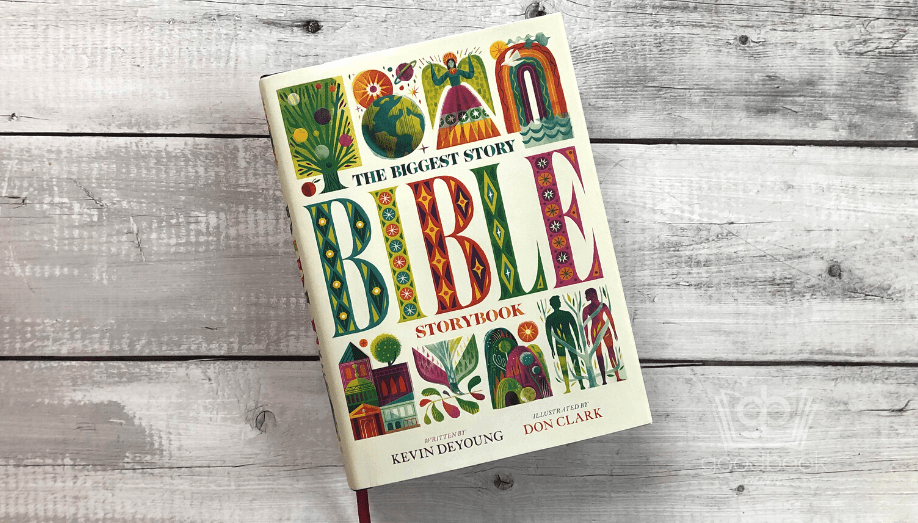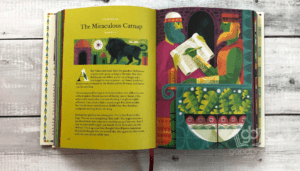
Summary
This Story Bible has 104 stories from the Bible divided into seven sections: The Pentateuch, History, Poetry, The Prophets, The Gospels, Acts and Epistles, and Revelation. Each story has a few pages of text that include large illustrations throughout. At the end of each story, there is a short prayer.
In the “Note to Parents,” the author is clear that this book is “not the inspired, unerring word of God,” but rather a “theologically minded and redemptively focused interpretation.”
Ages: Aimed at children 6-12
Mom Thoughts
 It doesn’t happen often, but sometimes I find a children’s book so skillfully written, so carefully crafted, and so biblically sound that I recommend it for adults as well. This is one of those rare books. Kevin DeYoung has written a treasure and instant heirloom for families to enjoy together for years and years.
It doesn’t happen often, but sometimes I find a children’s book so skillfully written, so carefully crafted, and so biblically sound that I recommend it for adults as well. This is one of those rare books. Kevin DeYoung has written a treasure and instant heirloom for families to enjoy together for years and years.
The text sticks to scripture with some small interjections of humor and frequent connections to Christ. There is some but minimal commentary, and what is present is usually to explain a bigger or complicated idea, or for clarity. The author does an excellent job of writing in language that children can understand without insulting their intelligence or “dumbing things down.”
The illustrations are absolutely breathtaking. Every single one could be framed and hung on your wall. I can’t tell you the number of times I said to my husband, “Wow, look at this one!” They are rather stylized, and while I think they are stunning masterpieces, they may not resonate with every child.
For those wondering if the author’s theological views concerning Covenant Theology versus Dispensationalism or if his eschatological views come through in the text, he avoids interjecting these pretty much altogether. In the section on Revelation, he doesn’t cover anything that happens on earth in the last days, rather focusing on the letter to the seven churches, the throne room of God, Satan being defeated, and the new heaven and new earth.
There are a couple of things worth noting. The text says, “Abram believed God, and God counted it to him as righteousness. Which is another way of saying God hands out A+’s just for taking him at his word.” Using a grading scale in relation to God’s judgment felt a little off. Does God hand out B-‘s too? I am sure I am overthinking what the author intended, but I thought it was slightly odd.
When retelling the story of Moses as a baby, the text says, “…and then made a little baby basket and sent him down the river. Sounds dangerous! But don’t worry, the baby was safe. In fact, he floated right to Pharaoh’s daughter…” Exodus says, concerning the baby basket, that Moses’s mother “…placed it among the reeds by the river bank,” and of Pharaoh’s daughter, “She saw the basket among the reeds and sent her servant woman, and she took it.” Obviously, this is a very minor detail that has been changed, but nonetheless, changed.
In reference to Solomon’s unfaithfulness, Solomon is referred to as “dumb.” When speaking of the dry bones vision God gave Ezekiel, it says of God, “Was he making plans for Halloween? No. The vision was not about haunted houses but about the house of Israel.”
There is an illustration of John the Baptist’s severed head. While it’s not gruesome and actually very well done, it might be a bit much for some younger children.
In reference to Jesus’ entrance to Jerusalem, it says, “You can’t shut up the whole world when its Creator comes to town.”
In regards to Jesus loving children, it says, “Even tiny babies can be part of his family.” Whether that means tiny babies can believe and be saved, or if God in his grace saves children who are unborn or who die very young, the author doesn’t elaborate.
Concerning the Parable of the Sower, it says, “The difference is not with the power of the seed or with the generosity of the sower, but with the goodness of the soil.” While I’m sure the author’s intent was not to mean this is our own goodness or something of the sort, I thought it was a slightly muddy explanation.
Something that I absolutely love about this story bible is the inclusion of many stories that are usually excluded for children: The Daughters of Zelophehad, Hosea, Amos, A Change of Clothes from Zechariah, The Parable of Laborers in the Vineyard, Ananias and Sapphira, Paul in Athens, and more.
There are also times when DeYoung takes a bit of a theological stand that I loved. Concerning Pharaoh’s hardness of heart, “That was Pharaoh’s fault. And God’s plan. All at the same time.” After telling Samuel’s story, it says, “God still speaks to us today, not by voices and dreams, but by the word of God in the Bible.” I was very happy to see these thoughts included.
While I have included some things to note, overall this is a fantastic story bible that points to Christ throughout, sticks to scripture, and has stunning illustrations. I would not hesitate for a single moment to fully recommend this to anyone. It is on my shortlist of truly good story bibles.
This post may contain affiliate links. Please read our disclaimer for more info.
Buy This Book

This is a Mom's Pick
At A Glance
| Number of Stories | Number of Pages |
|---|---|
| 104 | 529 |

